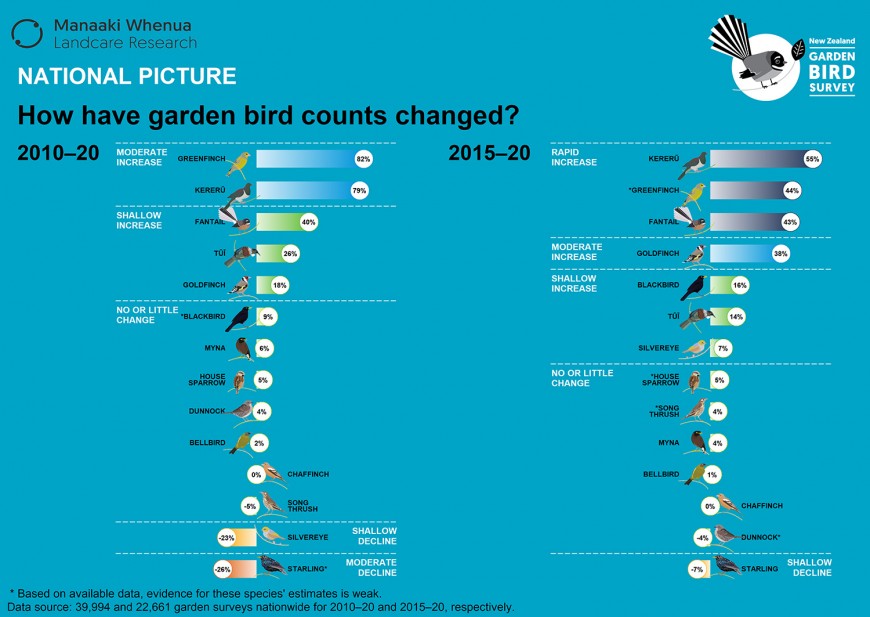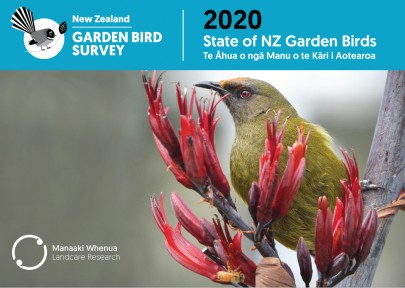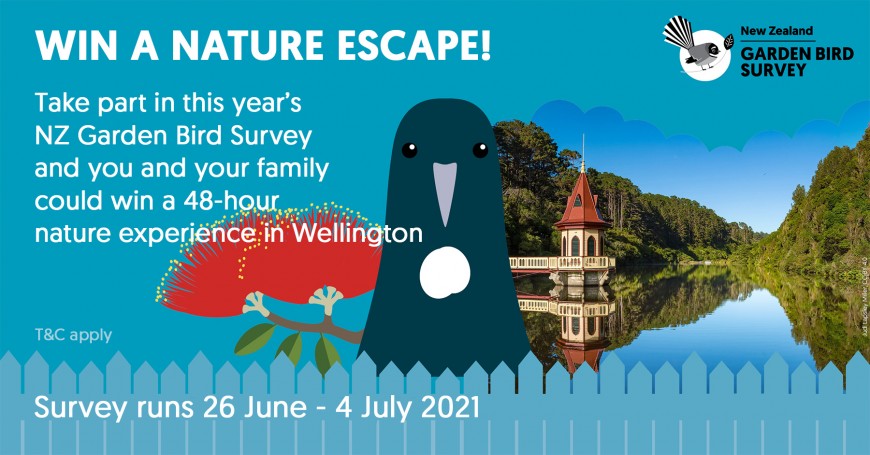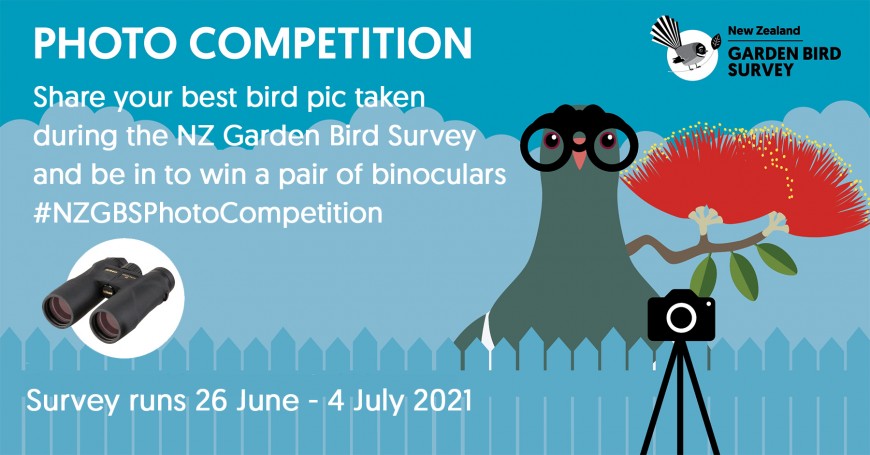The report outlines the latest results from New Zealand’s longest-running citizen science project – the New Zealand Garden Bird Survey. Since its inception in 2007, nearly 40,000 people across the country have joined the survey to count all the birds they see or hear in their garden in one hour on one day during a nine day period at the end of June.
The survey helps scientists understand the health of garden bird populations, and by association the wider environment. The report shows how bird counts are changing across Aotearoa over two timeframes – the past 5 and past 10 years. Significant changes in bird populations signal changes in the environment.
Last year’s survey shows good news for four native species:
- Kererū counts have moderately increased (by 79%) over the past 10 years and a rapid increase over the last 5 years (55%, or 11% annually).
- Fantail (pīwaiwaka) counts also show a shallow increase over the last 10 years, accelerating to a rapid increase over the last 5 years (43%, or 8.6% annually).
- Tūī (kōkō) counts still show a shallow increase over the long-term.
- Silvereye (tauhou) counts no longer moderately decline over the long-term – they now show only a shallow decline over the past 10 years. And, for the first time, silvereye counts show a 5-year increase (7%, or 1.4% per year) – shallowly increasing nationwide and moderately increasing in three regions (Manawatū-Whanganui, Marlborough, and Taranaki).
For our introduced species:
- Myna counts show little or no change over the last 10 years nationally, but a shallow increase in three regions (Bay of Plenty, Gisborne, and Manawatu-Wanganui), and a rapid increase in one region (Wellington).
- Starling counts continue to show a moderate decline (26%, or 2.6% per year) nationally over the long term.
- The numbers of song thrush, goldfinch and dunnock are no longer showing national declines over either the short or long term.
The NZ Garden Bird Survey founder, Dr Eric Spurr, says the results are very encouraging, and show the value of long-term citizen science monitoring. "After 15 years, the survey results clearly demonstrate that several native bird species, including kererū, tui, and fantail, are increasing in abundance in our gardens. The survey cannot determine the causes of these increases, but it is tempting to suggest that they reflect the results of ever-increasing community predator control and habitat restoration activities around the country."

How have garden bird counts changed? 2010-2020
As well as scientific data on bird numbers, researchers also collected information about how the public views their role as citizen scientists and the impact of science in their daily lives.
Environmental Social Science Researcher Dr. Gradon Diprose says the responses showed people felt a sense of connectedness both with nature and their communities after completing the survey.
“People report they feel they can contribute without having to join a group,” says Dr. Diprose. “People were happy to do the survey, because they could fit it around their other commitments, but still contribute in a meaningful way to a collective environmental effort.”
There was a silver lining to the COVID pandemic cloud for the NZ Garden Bird Survey, says Dr. Diprose. “2020 had the highest number of participants ever. Many people across Aotearoa New Zealand were increasingly focused on nature, and particularly birds in their gardens and neighbourhoods, due to the pandemic response that restricted people’s movements.
“It also triggered debates about how to restore nature and ensure human wellbeing, reflecting different priorities, aspirations and politics,” says Dr. Diprose.

Read State of New Zealand Garden Birds 2020 | Te āhua o ngā manu o te kāri i Aotearoa Bellbird image: Julie Gould
Participants were also using their own findings to inform what they are planting in their gardens to create bird-friendly habitats, and to talk to neighbours and friends about predator control in their immediate environments.
“Overwhelmingly, responses to the survey highlighted how spending an hour in the garden increased awareness of the biodiversity in our immediate environment, an increased knowledge of bird identification and behaviour, and improved well-being. We had people saying it was a good opportunity to slow down,” says Dr. Diprose. “Participants talked about feeling curiosity, joy, fun, wonder and a sense of connection.”
“For some of these participants, particularly new migrants, the NZ Garden Bird Survey was described as an important way to develop new place knowledge and attachments. For example, one participant said: ‘I came to NZ two years ago, participating in this survey made me more aware of New Zealand garden birds, especially after completing the bird survey quiz in Instagram’.”
This view was echoed by education officer for the Ministry of the Environment Benji Moorhouse, who praised the Survey’s educational resources. “The Survey is a fantastic opportunity to take teaching and learning outdoors. Whether it be your first adventure outdoors or you’re linking the survey to a wider inquiry learning topic, there is an incredible suite of curriculum linked education resources to support teachers and students with their garden bird survey, no matter where you are in Aotearoa. The survey is also a chance to keep learning and give back to nature through citizen science. It’s a great way to bring the ‘five ways to wellbeing’ into your school and community in the colder months.”
This year we have some new te reo Māori resources for all our kura, kaiako, tamariki and whānau taking part!
The release of the report signals the start of this year’s survey, which runs from Saturday, 26 June to Sunday, 4 July.
Follow @NZGardenBirds
You can also follow @NZGardenBirds on Facebook, Twitter and Instagram, join the NZ Garden Bird Survey Facebook group, and contribute to the conversation: #NZGardenBirdSurvey
2021 NZ Garden Bird Survey competitions
Every completed and submitted New Zealand Garden Bird Survey form gives people a chance to win a family getaway Nature Escape to Wellington. A pair of binoculars is also up for grabs for the best bird photo submitted during the survey. Terms and conditions apply: see website for details.
Links
- Report: State of NZ Garden Birds 2020 | Te Āhua o ngā Manu o te Kāri i Aotearoa Link
- Be in to win a nature escape to Wellington with the family by taking part in the NZ Garden Bird Survey Link
- NZ Garden Bird Survey photography competition Link
- NZ Garden Bird Survey resources for teachers & children Link
- Te reo Māori resources for children & teachers Link



